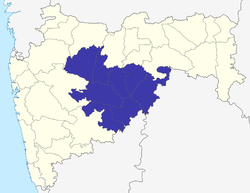Aurangabad division Marathwada | |
|---|---|
| Aurangabad division | |
 Aurangabad | |
| Coordinates: 19°53′19.63″N75°20′36.37″E / 19.8887861°N 75.3434361°E | |
| Country | |
| State | |
| Districts | |
| Government | |
| • Commissioner Aurangabad Division |
|
| • Police Commissioner Aurangabad Division | NA |
| • All Guardian Minister Aurangabad Division |
|
| • All District Collector's Aurangabad Division |
|
| • All MP's Aurangabad Division | NA |
| Area | |
• Total | 64,590.58 km2 (24,938.56 sq mi) |
| Population (2011) [1] | |
• Total | 18,731,872 |
| Languages [2] | |
| • Language | Marathi (official) Urdu Hindi Lambadi |
| Literacy | 76.49% [1] |
Aurangabad division, officially Chhatrapati Sambhajinagar division and also known as Marathwada division, is one of the six administrative divisions of the state of Maharashtra in India. It represents the Marathwada region of Maharashtra and is synonymous with it.